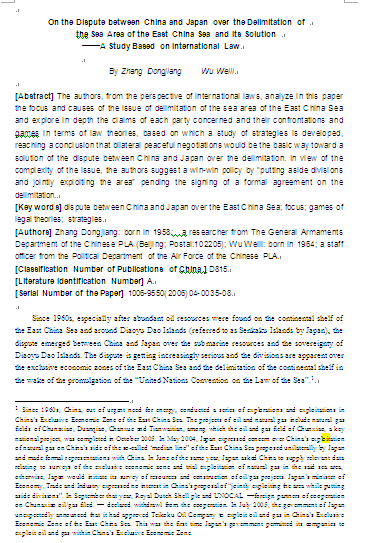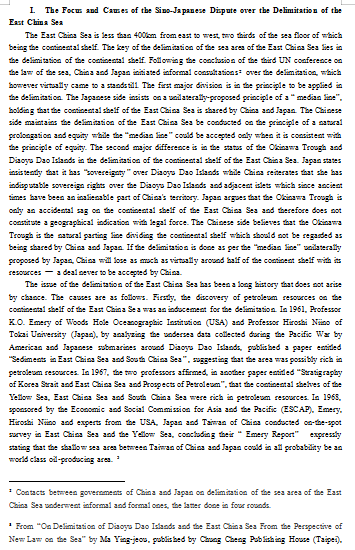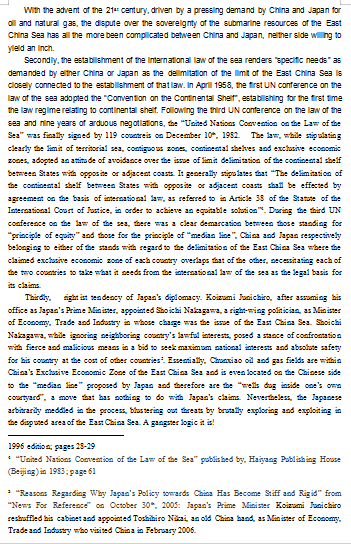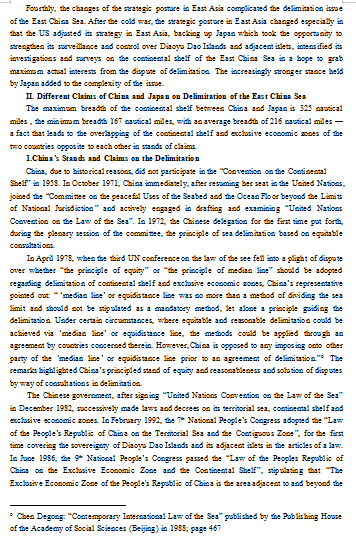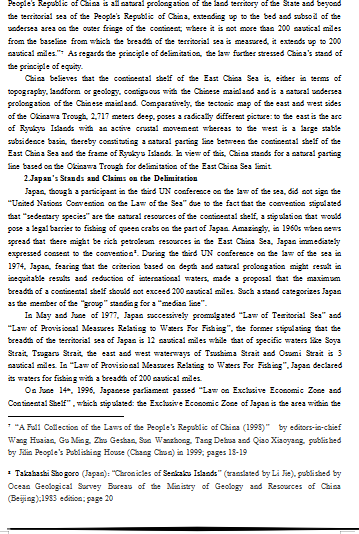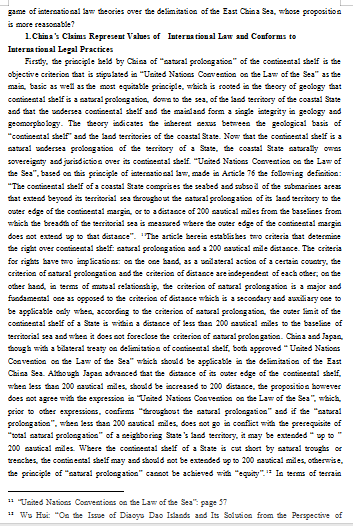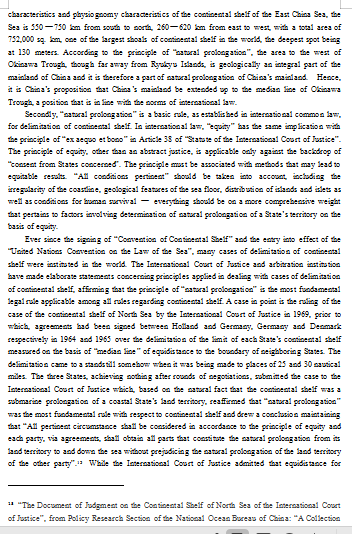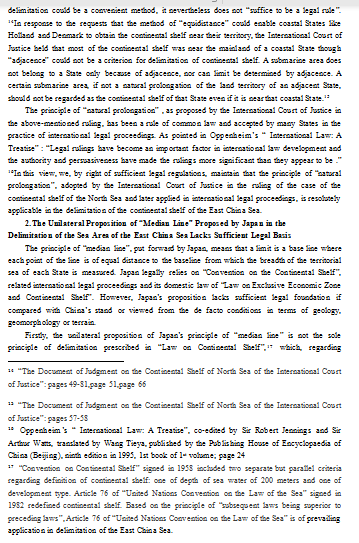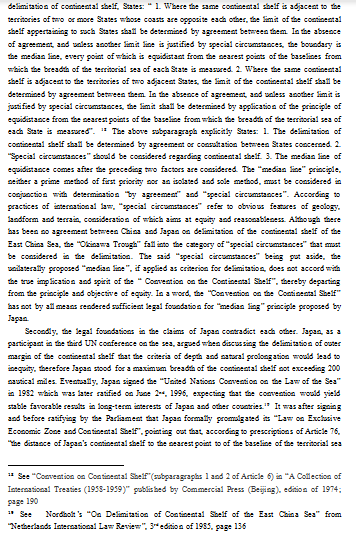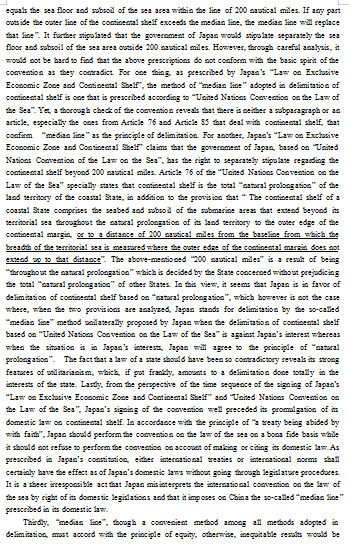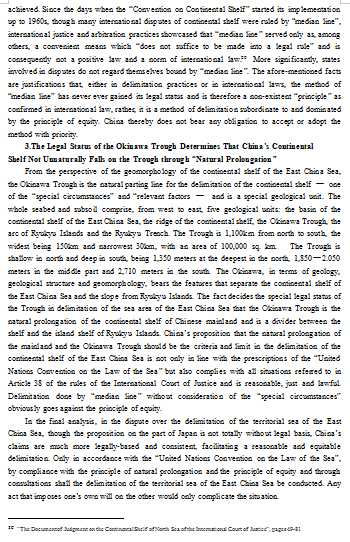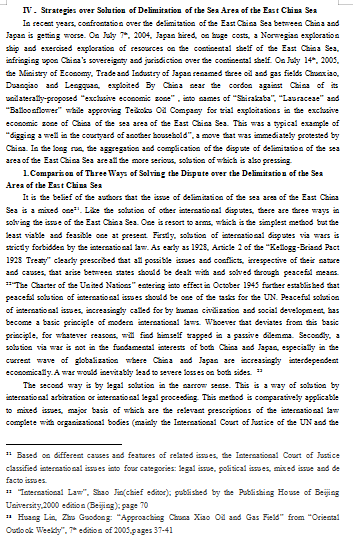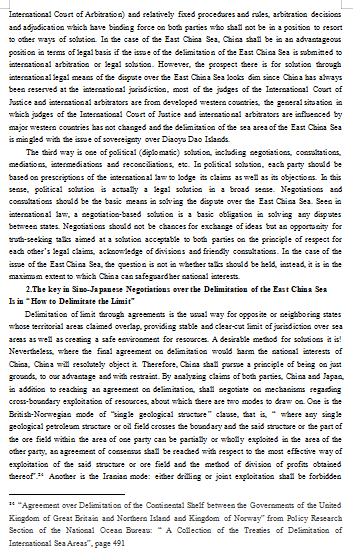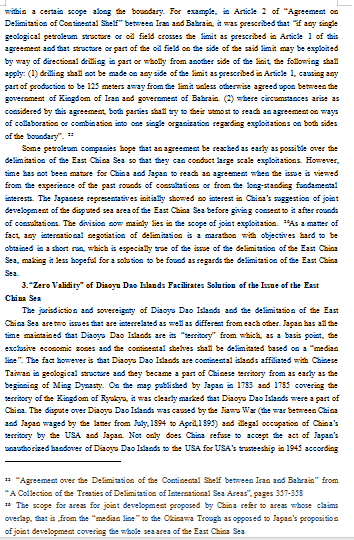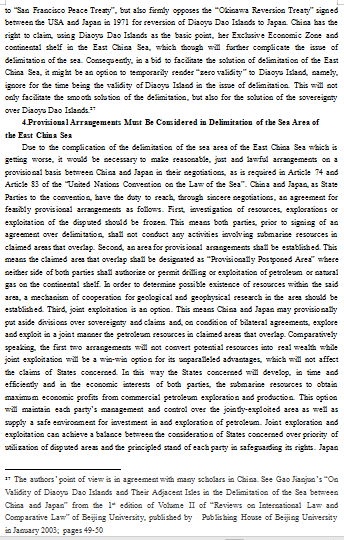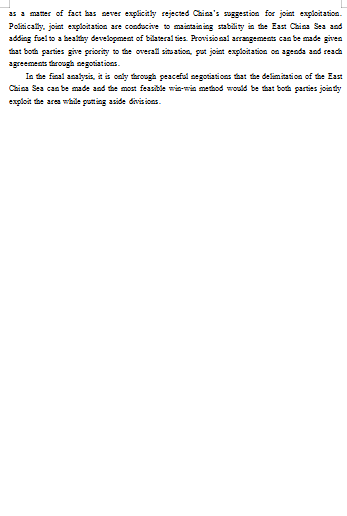On the Dispute between China and Japan over the Delimitation of the Sea Area of the East China Sea and Its Solution
——A Study Based on International Law By Zhang Dongjiang Wu Weili
[Abstract] The authors, from the perspective of international laws, analyze in this paper the focus and causes of the issue of delimitation of the sea area of the East China Sea and explore in depth the claims of each party concerned and their confrontations and games in terms of law theories, based on which a study of strategies is developed, reaching a conclusion that bilateral peaceful negotiations would be the basic way toward a solution of the dispute between China and Japan over the delimitation. In view of the complexity of the issue, the authors suggest a win-win policy by “putting aside divisions and jointly exploiting the area” pending the signing of a formal agreement on the delimitation.
[Key words] dispute between China and Japan over the East China Sea; focus; games of legal theories; strategies
[Authors] Zhang Dongjiang: born in 1958; a researcher from The General Armaments Department of the Chinese PLA (Beijing; Postal:102205); Wu Weili: born in 1964; a staff officer from the Political Department of the Air Force of the Chinese PLA
[Classification Number of Publications of China ] D815
[Literature Identification Number] A
[Serial Number of the Paper] 1006-9550(2006)04-0035-08
Since 1960s, especially after abundant oil resources were found on the continental shelf of the East China Sea and around Diaoyu Dao Islands (referred to as Senkaku Islands by Japan), the dispute emerged between China and Japan over the submarine resources and the sovereignty of Diaoyu Dao Islands. The dispute is getting increasingly serious and the divisions are apparent over the exclusive economic zones of the East China Sea and the delimitation of the continental shelf in the wake of the promulgation of the “United Nations Convention on the Law of the Sea”.
I. The Focus and Causes of the Sino-Japanese Dispute over the Delimitation of the East China Sea
The East China Sea is less than 400km from east to west, two thirds of the sea floor of which being the continental shelf. The key of the delimitation of the sea area of the East China Sea lies in the delimitation of the continental shelf. Following the conclusion of the third UN conference on the law of the sea, China and Japan initiated informal consultations over the delimitation, which however virtually came to a standstill. The first major division is in the principle to be applied in the delimitation. The Japanese side insists on a unilaterally-proposed principle of a “ median line”, holding that the continental shelf of the East China Sea is shared by China and Japan. The Chinese side maintains the delimitation of the East China Sea be conducted on the principle of a natural prolongation and equity while the “median line” could be accepted only when it is consistent with the principle of equity. The second major difference is in the status of the Okinawa Trough and Diaoyu Dao Islands in the delimitation of the continental shelf of the East China Sea. Japan states insistently that it has “sovereignty” over Diaoyu Dao Islands while China reiterates that she has indisputable sovereign rights over the Diaoyu Dao Islands and adjacent islets which since ancient times have been an inalienable part of China's territory. Japan argues that the Okinawa Trough is only an accidental sag on the continental shelf of the East China Sea and therefore does not constitute a geographical indication with legal force. The Chinese side believes that the Okinawa Trough is the natural parting line dividing the continental shelf which should not be regarded as being shared by China and Japan. If the delimitation is done as per the “median line” unilaterally proposed by Japan, China will lose as much as virtually around half of the continent shelf with its resources — a deal never to be accepted by China.
The issue of the delimitation of the East China Sea has been a long history that does not arise by chance. The causes are as follows. Firstly, the discovery of petroleum resources on the continental shelf of the East China Sea was an inducement for the delimitation. In 1961, Professor K.O. Emery of Woods Hole Oceanographic Institution (USA) and Professor Hiroshi Niino of Tokai University (Japan), by analyzing the undersea data collected during the Pacific War by American and Japanese submarines around Diaoyu Dao Islands, published a paper entitled “Sediments in East China Sea and South China Sea” , suggesting that the area was possibly rich in petroleum resources. In 1967, the two professors affirmed, in another paper entitled “Stratigraphy of Korea Strait and East China Sea and Prospects of Petroleum”, that the continental shelves of the Yellow Sea, East China Sea and South China Sea were rich in petroleum resources. In 1968, sponsored by the Economic and Social Commission for Asia and the Pacific (ESCAP), Emery, Hiroshi Niino and experts from the USA, Japan and Taiwan of China conducted on-the-spot survey in East China Sea and the Yellow Sea, concluding their “ Emery Report” expressly stating that the shallow sea area between Taiwan of China and Japan could in all probability be an world class oil-producing area.
With the advent of the 21st century, driven by a pressing demand by China and Japan for oil and natural gas, the dispute over the sovereignty of the submarine resources of the East China Sea has all the more been complicated between China and Japan, neither side willing to yield an inch.
Secondly, the establishment of the international law of the sea renders “specific needs” as demanded by either China or Japan as the delimitation of the limit of the East China Sea is closely connected to the establishment of that law. In April 1958, the first UN conference on the law of the sea adopted the “Convention on the Continental Shelf”, establishing for the first time the law regime relating to continental shelf. Following the third UN conference on the law of the sea and nine years of arduous negotiations, the “United Nations Convention on the Law of the Sea” was finally signed by 119 countreis on December 10th, 1982. The law, while stipulating clearly the limit of territorial sea, contiguous zones, continental shelves and exclusive economic zones, adopted an attitude of avoidance over the issue of limit delimitation of the continental shelf between States with opposite or adjacent coasts. It generally stipulates that “The delimitation of the continental shelf between States with opposite or adjacent coasts shall be effected by agreement on the basis of international law, as referred to in Article 38 of the Statute of the International Court of Justice, in order to achieve an equitable solution”. During the third UN conference on the law of the sea, there was a clear demarcation between those standing for “principle of equity” and those for the principle of “median line”, China and Japan respectively belonging to either of the stands with regard to the delimitation of the East China Sea where the claimed exclusive economic zone of each country overlaps that of the other, necessitating each of the two countries to take what it needs from the international law of the sea as the legal basis for its claims.
Thirdly, rightist tendency of Japan’s diplomacy. Koizumi Junichiro, after assuming his office as Japan’s Prime Minister, appointed Shoichi Nakagawa, a right-wing politician, as Minister of Economy, Trade and Industry in whose charge was the issue of the East China Sea. Shoichi Nakagawa, while ignoring neighboring country’s lawful interests, posed a stance of confrontation with fierce and malicious means in a bid to seek maximum national interests and absolute safety for his country at the cost of other countries. Essentially, Chunxiao oil and gas fields are within China’s Exclusive Economic Zone of the East China Sea and is even located on the Chinese side to the “median line” proposed by Japan and therefore are the “wells dug inside one’s own courtyard”, a move that has nothing to do with Japan’s claims. Nevertheless, the Japanese arbitrarily meddled in the process, blustering out threats by brutally exploring and exploiting in the disputed area of the East China Sea. A gangster logic it is!
Fourthly, the changes of the strategic posture in East Asia complicated the delimitation issue of the East China Sea. After the cold war, the strategic posture in East Asia changed especially in that the US adjusted its strategy in East Asia, backing up Japan which took the opportunity to strengthen its surveillance and control over Diaoyu Dao Islands and adjacent islets, intensified its investigations and surveys on the continental shelf of the East China Sea in a hope to grab maximum actual interests from the dispute of delimitation. The increasingly stronger stance held by Japan added to the complexity of the issue.
II. Different Claims of China and Japan on Delimitation of the East China Sea
The maximum breadth of the continental shelf between China and Japan is 325 nautical miles , the minimum breadth 167 nautical miles, with an average breadth of 216 nautical miles — a fact that leads to the overlapping of the continental shelf and exclusive economic zones of the two countries opposite to each other in stands of claims.
1.China’s Stands and Claims on the Delimitation
China, due to historical reasons, did not participate in the “Convention on the Continental Shelf” in 1958. In October 1971, China immediately, after resuming her seat in the United Nations, joined the “Committee on the peaceful Uses of the Seabed and the Ocean Floor beyond the Limits of National Jurisdiction” and actively engaged in drafting and examining “United Nations Convention on the Law of the Sea”. In 1972, the Chinese delegation for the first time put forth, during the plenary session of the committee, the principle of sea delimitation based on equitable consultations.
In April 1978, when the third UN conference on the law of the see fell into a plight of dispute over whether “the principle of equity” or “the principle of median line” should be adopted regarding delimitation of continental shelf and exclusive economic zones, China’s representative pointed out: “ ‘median line’ or equidistance line was no more than a method of dividing the sea limit and should not be stipulated as a mandatory method, let alone a principle guiding the delimitation. Under certain circumstances, where equitable and reasonable delimitation could be achieved via ‘median line’ or equidistance line, the methods could be applied through an agreement by countries concerned therein. However, China is opposed to any imposing onto other party of the ‘median line’ or equidistance line prior to an agreement of delimitation.” The remarks highlighted China’s principled stand of equity and reasonableness and solution of disputes by way of consultations in delimitation.
The Chinese government, after signing “United Nations Convention on the Law of the Sea” in December 1982, successively made laws and decrees on its territorial sea, continental shelf and exclusive economic zones. In February 1992, the 7th National People’s Congress adopted the “Law of the People’s Republic of China on the Territorial Sea and the Contiguous Zone”, for the first time covering the sovereignty of Diaoyu Dao Islands and its adjacent islets in the articles of a law. In June 1986, the 9th National People’s Congress passed the “Law of the Peoples Republic of China on the Exclusive Economic Zone and the Continental Shelf”, stipulating that “The Exclusive Economic Zone of the People's Republic of China is the area adjacent to and beyond the territorial sea of the People's Republic of China, extending as far as 200 nautical miles from the baseline from which the breadth of the territorial sea is measured. The continental shelf of the People's Republic of China is all natural prolongation of the land territory of the State and beyond the territorial sea of the People's Republic of China, extending up to the bed and subsoil of the undersea area on the outer fringe of the continent; where it is not more than 200 nautical miles from the baseline from which the breadth of the territorial sea is measured, it extends up to 200 nautical miles.” As regards the principle of delimitation, the law further stressed China’s stand of the principle of equity.
China believes that the continental shelf of the East China Sea is, either in terms of topography, landform or geology, contiguous with the Chinese mainland and is a natural undersea prolongation of the Chinese mainland. Comparatively, the tectonic map of the east and west sides of the Okinawa Trough, 2,717 meters deep, poses a radically different picture: to the east is the arc of Ryukyu Islands with an active crustal movement whereas to the west is a large stable subsidence basin, thereby constituting a natural parting line between the continental shelf of the East China Sea and the frame of Ryukyu Islands. In view of this, China stands for a natural parting line based on the Okinawa Trough for delimitation of the East China Sea limit.
2.Japan’s Stands and Claims on the Delimitation
Japan, though a participant in the third UN conference on the law of the sea, did not sign the “United Nations Convention on the Law of the Sea” due to the fact that the convention stipulated that “sedentary species” are the natural resources of the continental shelf, a stipulation that would pose a legal barrier to fishing of queen crabs on the part of Japan. Amazingly, in 1960s when news spread that there might be rich petroleum resources in the East China Sea, Japan immediately expressed consent to the convention. During the third UN conference on the law of the sea in 1974, Japan, fearing that the criterion based on depth and natural prolongation might result in inequitable results and reduction of international waters, made a proposal that the maximum breadth of a continental shelf should not exceed 200 nautical miles. Such a stand categorizes Japan as the member of the “group” standing for a “median line”.
In May and June of 1977, Japan successively promulgated “Law of Territorial Sea” and “Law of Provisional Measures Relating to Waters For Fishing”, the former stipulating that the breadth of the territorial sea of Japan is 12 nautical miles while that of specific waters like Soya Strait, Tsugaru Strait, the east and west waterways of Tsushima Strait and Osumi Strait is 3 nautical miles. In “Law of
Provisional Measures Relating to Waters For Fishing”, Japan declared its waters for fishing with a breadth of 200 nautical miles.
On June 14th, 1996, Japanese parliament passed “Law on Exclusive Economic Zone and Continental Shelf” , which stipulated: the Exclusive Economic Zone of Japan is the area within the line every point of which is of 200 nautical miles from the nearest points on the baseline from which the baseline of its territorial sea extends to the outside; where any part of the outer limit of exclusive economic zone exceeds the median line , the median line (or any line agreed upon between Japan and other States) shall take the place of the said line. It further states that Japan’s continental shelf comprises the sea floor and its subsoil in the sea area within the line from which the coastal line extends beyond the line every point of which is nearest to the baseline of its territorial line. Regarding delimitation of the East China Sea, Japan argues that “United Nations Convention on the Law of the Sea” was made based on topography and geomorphology of the Atlantic Ocean and is therefore not applicable to the East China Sea with complex topography and the Pacific waters. According to studies of Professor Kimura Masaaki of University of the Ryukyus, China and Japan share a continental shelf in the East China Sea and the Okinawa Trough is only an accidental sag between the natural prolongation which cannot intermit the continuity of the prolongation of the continental shelf of the two countries. In view of this, Japan claims that the legal force of the Okinawa Trough should be neglected in the delimitation of the East China Sea.
In conclusion, Sino-Japanese divisions over the delimitation of the East China Sea boil down to two points. One is in different principles applied in the delimitation. Japan stands for what they call a “median line” of equidistance and a criterion of distance while China for the principle of natural prolongation of the continental shelf. Another is in the dispute over whether the two parties share a continental shelf. China believes that the continental shelf of the East China Sea and the Okinawa Trough are two different units, the former being a stable continental crust whereas the latter being a structural belt in the transition of continental shelf to oceanic crust, making Okinawa Trough a natural parting line between the continental shelf of the natural prolongation of the Chinese mainland and the frame of the Ryukyu Islands. In contrast, it is Japan’s contention that China and Japan are on a shared continental shelf, China’s continental shelf terminates at Ryukyu Trench, the Ryukyu Islands are island chains on the outer edge of the continental shelf, the Okinawa Trough is merely a fold and sag on the continental shelf and should not serve as a decisive factor in the delimitation.
III. Sino-Japanese Games over International Law Theories Concerning Delimitation of the East China Sea
As stipulated in “United Nations Convention on the Law of the Sea”, each coastal State owns sovereignty over “near to the sea region”. Over the delimitation of the East China Sea, both China and Japan can find basis from the criteria of international law to justify respective claims which are affirmed in domestic laws. Consequently, a “war of law” without smoke of gunpowder was waged in either consultations and negotiations or publicities to the world. People may ask: in the game of international law theories over the delimitation of the East China Sea, whose proposition is more reasonable?
1.China’s Claims Represent Values of International Law and Conforms to
International Legal Practices
Firstly, the principle held by China of “natural prolongation” of the continental shelf is the objective criterion that is stipulated in “United Nations Convention on the Law of the Sea” as the main, basic as well as the most equitable principle, which is rooted in the theory of geology that continental shelf is a natural prolongation, down to the sea, of the land territory of the coastal State and that the undersea continental shelf and the mainland form a single integrity in geology and geomorphology. The theory indicates the inherent nexus between the geological basis of “continental shelf” and the land territories of the coastal State. Now that the continental shelf is a natural undersea prolongation of the territory of a State, the coastal State naturally owns sovereignty and jurisdiction over its continental shelf. “United Nations Convention on the Law of the Sea”, based on this principle of international law, made in Article 76 the following definition: “The continental shelf of a coastal State comprises the seabed and subsoil of the submarines areas that extend beyond its territorial sea throughout the natural prolongation of its land territory to the outer edge of the continental margin, or to a distance of 200 nautical miles from the baselines from which the breadth of the territorial sea is measured where the outer edge of the continental margin does not extend up to that distance”. The article herein establishes two criteria that determine the right over continental shelf: natural prolongation and a 200 nautical mile distance. The criteria for rights have two implications: on the one hand, as a unilateral action of a certain country, the criterion of natural prolongation and the criterion of distance are independent of each other; on the other hand, in terms of mutual relationship, the criterion of natural prolongation is a major and fundamental one as opposed to the criterion of distance which is a secondary and auxiliary one to be applicable only when, according to the criterion of natural prolongation, the outer limit of the continental shelf of a State is within a distance of less than 200 nautical miles to the baseline of territorial sea and when it does not foreclose the criterion of natural prolongation. China and Japan, though with a bilateral treaty on delimitation of continental shelf, both approved “ United Nations Convention on the Law of the Sea” which should be applicable in the delimitation of the East China Sea. Although Japan advanced that the distance of its outer edge of the continental shelf, when less than 200 nautical miles, should be increased to 200 distance, the proposition however does not agree with the expression in “United Nations Convention on the Law of the Sea”, which, prior to other expressions, confirms “throughout the natural prolongation” and if the “natural prolongation”, when less than 200 nautical miles, does not go in conflict with the prerequisite of “total natural prolongation” of a neighboring State’s land territory, it may be extended “ up to ” 200 nautical miles. Where the continental shelf of a State is cut short by natural troughs or trenches, the continental shelf may and should not be extended up to 200 nautical miles, otherwise, the principle of “natural prolongation” cannot be achieved with “equity”. In terms of terrain characteristics and physiognomy characteristics of the continental shelf of the East China Sea, the Sea is 550—750 km from south to north, 260—620 km from east to west, with a total area of 752,000 sq. km, one of the largest shoals of continental shelf in the world, the deepest spot being at 130 meters. According to the principle of “natural prolongation”, the area to the west of Okinawa Trough, though far away from Ryukyu Islands, is geologically an integral part of the mainland of China and it is therefore a part of natural prolongation of China’s mainland. Hence, it is China’s proposition that China’s mainland be extended up to the median line of Okinawa Trough, a position that is in line with the norms of international law.
Secondly, “natural prolongation” is a basic rule, as established in international common law, for delimitation of continental shelf. In international law, “equity” has the same implication with the principle of “ex aequo et bono” in Article 38 of “Statute of the International Court of Justice”. The principle of equity, other than an abstract justice, is applicable only against the backdrop of “consent from States concerned”. The principle must be associated with methods that may lead to equitable results. “All conditions pertinent” should be taken into account, including the irregularity of the coastline, geological features of the sea floor, distribution of islands and islets as well as conditions for human survival — everything should be on a more comprehensive weight that pertains to factors involving determination of natural prolongation of a State’s territory on the basis of equity.
Ever since the signing of “Convention of Continental Shelf” and the entry into effect of the “United Nations Convention on the Law of the Sea”, many cases of delimitation of continental shelf were instituted in the world. The International Court of Justice and arbitration institution have made elaborate statements concerning principles applied in dealing with cases of delimitation of continental shelf, affirming that the principle of “natural prolongation” is the most fundamental legal rule applicable among all rules regarding continental shelf. A case in point is the ruling of the case of the continental shelf of North Sea by the International Court of Justice in 1969, prior to which, agreements had been signed between Holland and Germany, Germany and Denmark respectively in 1964 and 1965 over the delimitation of the limit of each State’s continental shelf measured on the basis of “median line” of equidistance to the boundary of neighboring States. The delimitation came to a standstill somehow when it was being made to places of 25 and 30 nautical miles. The three States, achieving nothing after rounds of negotiations, submitted the case to the International Court of Justice which, based on the natural fact that the continental shelf was a submarine prolongation of a coastal State’s land territory, reaffirmed that “natural prolongation” was the most fundamental rule with respect to continental shelf and drew a conclusion maintaining that “All pertinent circumstance shall be considered in accordance to the principle of equity and each party, via agreements, shall obtain all parts that constitute the natural prolongation from its land territory to and down the sea without prejudicing the natural prolongation of the land territory of the other party”. While the International Court of Justice admitted that equidistance for delimitation could be a convenient method, it nevertheless does not “suffice to be a legal rule”. In response to the requests that the method of “equidistance” could enable coastal States like Holland and Denmark to obtain the continental shelf near their territory, the International Court of Justice held that most of the continental shelf was near the mainland of a coastal State though “adjacence” could not be a criterion for delimitation of continental shelf. A submarine area does not belong to a State only because of adjacence, nor can limit be determined by adjacence. A certain submarine area, if not a natural prolongation of the land territory of an adjacent State, should not be regarded as the continental shelf of that State even if it is near that coastal State.
The principle of “natural prolongation” , as proposed by the International Court of Justice in the above-mentioned ruling, has been a rule of common law and accepted by many States in the practice of international legal proceedings. As pointed in Oppenheim’s “ International Law: A Treatise” : “Legal rulings have become an important factor in international law development and the authority and persuasiveness have made the rulings more significant than they appear to be .” In this view, we, by right of sufficient legal regulations, maintain that the principle of “natural prolongation”, adopted by the International Court of Justice in the ruling of the case of the continental shelf of the North Sea and later applied in international legal proceedings, is resolutely applicable in the delimitation of the continental shelf of the East China Sea.
2.The Unilateral Proposition of “Median Line” Proposed by Japan in the Delimitation of the Sea Area of the East China Sea Lacks Sufficient Legal Basis
The principle of “median line”, put forward by Japan, means that a limit is a base line where each point of the line is of equal distance to the baseline from which the breadth of the territorial sea of each State is measured. Japan legally relies on “Convention on the Continental Shelf”, related international legal proceedings and its domestic law of “Law on Exclusive Economic Zone and Continental Shelf”. However, Japan’s proposition lacks sufficient legal foundation if compared with China’s stand or viewed from the de facto conditions in terms of geology, geomorphology or terrain.
Firstly, the unilateral proposition of Japan’s principle of “median line” is not the sole principle of delimitation prescribed in “Law on Continental Shelf”, which, regarding delimitation of continental shelf, States: “ 1. Where the same continental shelf is adjacent to the territories of two or more States whose coasts are opposite each other, the limit of the continental shelf appertaining to such States shall be determined by agreement between them. In the absence of agreement, and unless another limit line is justified by special circumstances, the boundary is the median line, every point of which is equidistant from the nearest points of the baselines from which the breadth of the territorial sea of each State is measured. 2. Where the same continental shelf is adjacent to the territories of two adjacent States, the limit of the continental shelf shall be determined by agreement between them. In the absence of agreement, and unless another limit is justified by special circumstances, the limit shall be determined by application of the principle of equidistance from the nearest points of the baseline from which the breadth of the territorial sea of each State is measured”. The above subparagraph explicitly States: 1. The delimitation of continental shelf shall be determined by agreement or consultation between States concerned. 2. “Special circumstances” should be considered regarding continental shelf. 3. The median line of equidistance comes after the preceding two factors are considered. The “median line” principle, neither a prime method of first priority nor an isolated and sole method, must be considered in conjunction with determination “by agreement” and “special circumstances”. According to practices of international law, “special circumstances” refer to obvious features of geology, landform and terrain, consideration of which aims at equity and reasonableness. Although there has been no agreement between China and Japan on delimitation of the continental shelf of the East China Sea, the “Okinawa Trough” fall into the category of “special circumstances” that must be considered in the delimitation. The said “special circumstances” being put aside, the unilaterally proposed “median line”, if applied as criterion for delimitation, does not accord with the true implication and spirit of the “ Convention on the Continental Shelf”, thereby departing from the principle and objective of equity. In a word, the “Convention on the Continental Shelf” has not by all means rendered sufficient legal foundation for “median ling” principle proposed by Japan.
Secondly, the legal foundations in the claims of Japan contradict each other. Japan, as a participant in the third UN conference on the sea, argued when discussing the delimitation of outer margin of the continental shelf that the criteria of depth and natural prolongation would lead to inequity, therefore Japan stood for a maximum breadth of the continental shelf not exceeding 200 nautical miles. Eventually, Japan signed the “United Nations Convention on the Law of the Sea” in 1982 which was later ratified on June 2nd, 1996, expecting that the convention would yield stable favorable results in long-term interests of Japan and other countries. It was after signing and before ratifying by the Parliament that Japan formally promulgated its “Law on Exclusive Economic Zone and Continental Shelf”, pointing out that, according to prescriptions of Article 76, “the distance of Japan’s continental shelf to the nearest point to of the baseline of the territorial sea equals the sea floor and subsoil of the sea area within the line of 200 nautical miles. If any part outside the outer line of the continental shelf exceeds the median line, the median line will replace that line”. It further stipulated that the government of Japan would stipulate separately the sea floor and subsoil of the sea area outside 200 nautical miles. However, through careful analysis, it would not be hard to find that the above prescriptions do not conform with the basic spirit of the convention as they contradict. For one thing, as prescribed by Japan’s “Law on Exclusive Economic Zone and Continental Shelf”, the method of “median line” adopted in delimitation of continental shelf is one that is prescribed according to “United Nations Convention on the Law of the Sea”. Yet, a thorough check of the convention reveals that there is neither a subparagraph or an article, especially the ones from Article 76 and Article 85 that deal with continental shelf, that confirm “median line” as the principle of delimitation. For another, Japan’s “Law on Exclusive Economic Zone and Continental Shelf” claims that the government of Japan, based on “United Nations Convention of the Law on the Sea”, has the right to separately stipulate regarding the continental shelf beyond 200 nautical miles. Article 76 of the “United Nations Convention on the Law of the Sea” specially states that continental shelf is the total “natural prolongation” of the land territory of the coastal State, in addition to the provision that “ The continental shelf of a coastal State comprises the seabed and subsoil of the submarine areas that extend beyond its territorial sea throughout the natural prolongation of its land territory to the outer edge of the continental margin, or to a distance of 200 nautical miles from the baseline from which the breadth of the territorial sea is measured where the outer edge of the continental margin does not extend up to that distance”. The above-mentioned “200 nautical miles” is a result of being “throughout the natural prolongation” which is decided by the State concerned without prejudicing the total “natural prolongation” of other States. In this view, it seems that Japan is in favor of delimitation of continental shelf based on “natural prolongation”, which however is not the case where, when the two provisions are analyzed, Japan stands for delimitation by the so-called “median line” method unilaterally proposed by Japan when the delimitation of continental shelf based on “United Nations Convention on the Law of the Sea” is against Japan’s interest whereas when the situation is in Japan’s interests, Japan will agree to the principle of “natural prolongation”. The fact that a law of a state should have been so contradictory reveals its strong features of utilitarianism, which, if put frankly, amounts to a delimitation done totally in the interests of the state. Lastly, from the perspective of the time sequence of the signing of Japan’s “Law on Exclusive Economic Zone and Continental Shelf” and “United Nations Convention on the Law of the Sea”, Japan’s signing of the convention well preceded its promulgation of its domestic law on continental shelf. In accordance with the principle of “a treaty being abided by with faith”, Japan should perform the convention on the law of the sea on a bona fide basis while it should not refuse to perform the convention on account of making or citing its domestic law. As prescribed in Japan’s constitution, either international treaties or international norms shall certainly have the effect as of Japan’s domestic laws without going through legislature procedures. It is a sheer irresponsible act that Japan misinterprets the international convention on the law of the sea by right of its domestic legislations and that it imposes on China the so-called “median line” prescribed in its domestic law.
Thirdly, “median line”, though a convenient method among all methods adopted in delimitation, must accord with the principle of equity, otherwise, inequitable results would be achieved. Since the days when the “Convention on Continental Shelf” started its implementation up to 1960s, though many international disputes of continental shelf were ruled by “median line”, international justice and arbitration practices showcased that “median line” served only as, among others, a convenient means which “does not suffice to be made into a legal rule” and is consequently not a positive law and a norm of international law. More significantly, states involved in disputes do not regard themselves bound by “median line”. The afore-mentioned facts are justifications that, either in delimitation practices or in international laws, the method of “median line” has never ever gained its legal status and is therefore a non-existent “principle” as confirmed in international law, rather, it is a method of delimitation subordinate to and dominated by the principle of equity. China thereby does not bear any obligation to accept or adopt the method with priority.
3.The Legal Status of the Okinawa Trough Determines That China’s Continental
Shelf Not Unnaturally Falls on the Trough through “Natural Prolongation”
From the perspective of the geomorphology of the continental shelf of the East China Sea, the Okinawa Trough is the natural parting line for the delimitation of the continental shelf — one of the “special circumstances” and “relevant factors — and is a special geological unit. The whole seabed and subsoil comprise, from west to east, five geological units: the basin of the continental shelf of the East China Sea, the ridge of the continental shelf, the Okinawa Trough, the arc of Ryukyu Islands and the Ryukyu Trench. The Trough is 1,100km from north to south, the widest being 150km and narrowest 30km, with an area of 100,000 sq. km. The Trough is shallow in north and deep in south, being 1,350 meters at the deepest in the north, 1,850—2.050 meters in the middle part and 2,710 meters in the south. The Okinawa, in terms of geology, geological structure and geomorphology, bears the features that separate the continental shelf of the East China Sea and the slope from Ryukyu Islands. The fact decides the special legal status of the Trough in delimitation of the sea area of the East China Sea that the Okinawa Trough is the natural prolongation of the continental shelf of Chinese mainland and is a divider between the shelf and the island shelf of Ryukyu Islands. China’s proposition that the natural prolongation of the mainland and the Okinawa Trough should be the criteria and limit in the delimitation of the continental shelf of the East China Sea is not only in line with the prescriptions of the “United Nations Convention on the Law of the Sea” but also complies with all situations referred to in Article 38 of the rules of the International Court of Justice and is reasonable, just and lawful. Delimitation done by “median line” without consideration of the “special circumstances” obviously goes against the principle of equity.
In the final analysis, in the dispute over the delimitation of the territorial sea of the East China Sea, though the proposition on the part of Japan is not totally without legal basis, China’s claims are much more legally-based and consistent, facilitating a reasonable and equitable delimitation. Only in accordance with the “United Nations Convention on the Law of the Sea”, by compliance with the principle of natural prolongation and the principle of equity and through consultations shall the delimitation of the territorial sea of the East China Sea be conducted. Any act that imposes one’s own will on the other would only complicate the situation.
IV.Strategies over Solution of Delimitation of the Sea Area of the East China Sea
In recent years, confrontation over the delimitation of the East China Sea between China and Japan is getting worse. On July 7th, 2004, Japan hired, on huge costs, a Norwegian exploration ship and exercised exploration of resources on the continental shelf of the East China Sea, infringing upon China’s sovereignty and jurisdiction over the continental shelf. On July 14th, 2005, the Ministry of Economy, Trade and Industry of Japan renamed three oil and gas fields Chunxiao, Duanqiao and Lengquan, exploited By China near the cordon against China of its unilaterally-proposed “exclusive economic zone” , into names of “Shirakaba”, “Lauraceae” and “Balloonflower” while approving Teikoku Oil Company for trial exploitations in the exclusive economic zone of China of the sea area of the East China Sea. This was a typical example of “digging a well in the courtyard of another household”, a move that was immediately protested by China. In the long run, the aggregation and complication of the dispute of delimitation of the sea area of the East China Sea are all the more serious, solution of which is also pressing.
1.Comparison of Three Ways of Solving the Dispute over the Delimitation of the Sea
Area of the East China Sea
It is the belief of the authors that the issue of delimitation of the sea area of the East China Sea is a mixed one. Like the solution of other international disputes, there are three ways in solving the issue of the East China Sea. One is resort to arms, which is the simplest method but the least viable and feasible one at present. Firstly, solution of international disputes via wars is strictly forbidden by the international law. As early as 1928, Article 2 of the “Kellogg-Briand Pact 1928 Treaty” clearly prescribed that all possible issues and conflicts, irrespective of their nature and causes, that arise between states should be dealt with and solved through peaceful means. “The Charter of the United Nations” entering into effect in October 1945 further established that peaceful solution of international issues should be one of the tasks for the UN. Peaceful solution of international issues, increasingly called for by human civilization and social development, has become a basic principle of modern international laws. Whoever that deviates from this basic principle, for whatever reasons, will find himself trapped in a passive dilemma. Secondly, a solution via war is not in the fundamental interests of both China and Japan, especially in the current wave of globalization where China and Japan are increasingly interdependent economically. A war would inevitably lead to severe losses on both sides.
The second way is by legal solution in the narrow sense. This is a way of solution by international arbitration or international legal proceeding. This method is comparatively applicable to mixed issues, major basis of which are the relevant prescriptions of the international law complete with organizational bodies (mainly the International Court of Justice of the UN and the International Court of Arbitration) and relatively fixed procedures and rules, arbitration decisions and adjudication which have binding force on both parties who shall not be in a position to resort to other ways of solution. In the case of the East China Sea, China shall be in an advantageous position in terms of legal basis if the issue of the delimitation of the East China Sea is submitted to international arbitration or legal solution. However, the prospect there is for solution through international legal means of the dispute over the East China Sea looks dim since China has always been reserved at the international jurisdiction, most of the judges of the International Court of Justice and international arbitrators are from developed western countries, the general situation in which judges of the International Court of Justice and international arbitrators are influenced by major western countries has not changed and the delimitation of the sea area of the East China Sea is mingled with the issue of sovereignty over Diaoyu Dao Islands.
The third way is one of political (diplomatic) solution, including negotiations, consultations, mediations, intermediations and reconciliations, etc. In political solution, each party should be based on prescriptions of the international law to lodge its claims as well as its objections. In this sense, political solution is actually a legal solution in a broad sense. Negotiations and consultations should be the basic means in solving the dispute over the East China Sea. Seen in international law, a negotiation-based solution is a basic obligation in solving any disputes between states. Negotiations should not be chances for exchange of ideas but an opportunity for truth-seeking talks aimed at a solution acceptable to both parties on the principle of respect for each other’s legal claims, acknowledge of divisions and friendly consultations. In the case of the issue of the East China Sea, the question is not in whether talks should be held, instead, it is in the maximum extent to which China can safeguard her national interests.
2.The key in Sino-Japanese Negotiations over the Delimitation of the East China Sea Is in “How to Delimitate the Limit”
Delimitation of limit through agreements is the usual way for opposite or neighboring states whose territorial areas claimed overlap, providing stable and clear-cut limit of jurisdiction over sea areas as well as creating a safe environment for resources. A desirable method for solutions it is! Nevertheless, where the final agreement on delimitation would harm the national interests of China, China will resolutely object it. Therefore, China shall pursue a principle of being on just grounds, to our advantage and with restraint. By analyzing claims of both parties, China and Japan, in addition to reaching an agreement on delimitation, shall negotiate on mechanisms regarding cross-boundary exploitation of resources, about which there are two modes to draw on. One is the British-Norwegian mode of “single geological structure” clause, that is, “ where any single geological petroleum structure or oil field crosses the boundary and the said structure or the part of the ore field within the area of one party can be partially or wholly exploited in the area of the other party, an agreement of consensus shall be reached with respect to the most effective way of exploitation of the said structure or ore field and the method of division of profits obtained thereof”. Another is the Iranian mode: either drilling or joint exploitation shall be forbidden within a certain scope along the boundary. For example, in Article 2 of “Agreement on Delimitation of Continental Shelf” between Iran and Bahrain, it was prescribed that “if any single geological petroleum structure or oil field crosses the limit as prescribed in Article 1 of this agreement and that structure or part of the oil field on the side of the said limit may be exploited by way of directional drilling in part or wholly from another side of the linit, the following shall apply: (1) drilling shall not be made on any side of the limit as prescribed in Article 1, causing any part of production to be 125 meters away from the limit unless otherwise agreed upon between the government of Kingdom of Iran and government of Bahrain. (2) where circumstances arise as considered by this agreement, both parties shall try to their utmost to reach an agreement on ways of collaboration or combination into one single organization regarding exploitations on both sides of the boundary”.
Some petroleum companies hope that an agreement be reached as early as possible over the delimitation of the East China Sea so that they can conduct large scale exploitations. However, time has not been mature for China and Japan to reach an agreement when the issue is viewed from the experience of the past rounds of consultations or from the long-standing fundamental interests. The Japanese representatives initially showed no interest in China’s suggestion of joint development of the disputed sea area of the East China Sea before giving consent to it after rounds of consultations. The division now mainly lies in the scope of joint exploitation. As a matter of fact, any international negotiation of delimitation is a marathon with objectives hard to be obtained in a short run, which is especially true of the issue of the delimitation of the East China Sea, making it less hopeful for a solution to be found as regards the delimitation of the East China Sea.
3.“Zero Validity” of Diaoyu Dao Islands Facilitates Solution of the Issue of the East China Sea
The jurisdiction and sovereignty of Diaoyu Dao Islands and the delimitation of the East China Sea are two issues that are interrelated as well as different from each other. Japan has all the time maintained that Diaoyu Dao Islands are its “territory” from which, as a basis point, the exclusive economic zones and the continental shelves shall be delimitated based on a “median line”. The fact however is that Diaoyu Dao Islands are continental islands affiliated with Chinese Taiwan in geological structure and they became a part of Chinese territory from as early as the beginning of Ming Dynasty. On the map published by Japan in 1783 and 1785 covering the territory of the Kingdom of Ryukyu, it was clearly marked that Diaoyu Dao Islands were a part of China. The dispute over Diaoyu Dao Islands was caused by the Jiawu War (the war between China and Japan waged by the latter from July,1894 to April,1895) and illegal occupation of China’s territory by the USA and Japan. Not only does China refuse to accept the act of Japan’s unauthorized handover of Diaoyu Dao Islands to the USA for USA’s trusteeship in 1945 according to “San Francisco Peace Treaty”, but also firmly opposes the “Okinawa Reversion Treaty” signed between the USA and Japan in 1971 for reversion of Diaoyu Dao Islands to Japan. China has the right to claim, using Diaoyu Dao Islands as the basic point, her Exclusive Economic Zone and continental shelf in the East China Sea, which though will further complicate the issue of delimitation of the sea. Consequently, in a bid to facilitate the solution of delimitation of the East China Sea, it might be an option to temporarily render “zero validity” to Diaoyu Island, namely, ignore for the time being the validity of Diaoyu Island in the issue of delimitation. This will not only facilitate the smooth solution of the delimitation, but also for the solution of the sovereignty over Diaoyu Dao Islands.
4.Provisional Arrangements Must Be Considered in Delimitation of the Sea Area of the East China Sea
Due to the complication of the delimitation of the sea area of the East China Sea which is getting worse, it would be necessary to make reasonable, just and lawful arrangements on a provisional basis between China and Japan in their negotiations, as is required in Article 74 and Article 83 of the “United Nations Convention on the Law of the Sea”. China and Japan, as State Parties to the convention, have the duty to reach, through sincere negotiations, an agreement for feasibly provisional arrangements as follows. First, investigation of resources, explorations or exploitation of the disputed should be frozen. This means both parties, prior to signing of an agreement over delimitation, shall not conduct any activities involving submarine resources in claimed areas that overlap. Second, an area for provisional arrangements shall be established. This means the claimed area that overlap shall be designated as “Provisionally Postponed Area” where neither side of both parties shall authorize or permit drilling or exploitation of petroleum or natural gas on the continental shelf. In order to determine possible existence of resources within the said area, a mechanism of cooperation for geological and geophysical research in the area should be established. Third, joint exploitation is an option. This means China and Japan may provisionally put aside divisions over sovereignty and claims and, on condition of bilateral agreements, explore and exploit in a joint manner the petroleum resources in claimed areas that overlap. Comparatively speaking, the first two arrangements will not convert potential resources into real wealth while joint exploitation will be a win-win option for its unparalleled advantages, which will not affect the claims of States concerned. In this way the States concerned will develop, in time and efficiently and in the economic interests of both parties, the submarine resources to obtain maximum economic profits from commercial petroleum exploration and production. This option will maintain each party’s management and control over the jointly-exploited area as well as supply a safe environment for investment in and exploration of petroleum. Joint exploration and exploitation can achieve a balance between the consideration of States concerned over priority of utilization of disputed areas and the principled stand of each party in safeguarding its rights. Japan as a matter of fact has never explicitly rejected China’s suggestion for joint exploitation. Politically, joint exploitation are conducive to maintaining stability in the East China Sea and adding fuel to a healthy development of bilateral ties. Provisional arrangements can be made given that both parties give priority to the overall situation, put joint exploitation on agenda and reach agreements through negotiations.
In the final analysis, it is only through peaceful negotiations that the delimitation of the East China Sea can be made and the most feasible win-win method would be that both parties jointly exploit the area while putting aside divisions.
